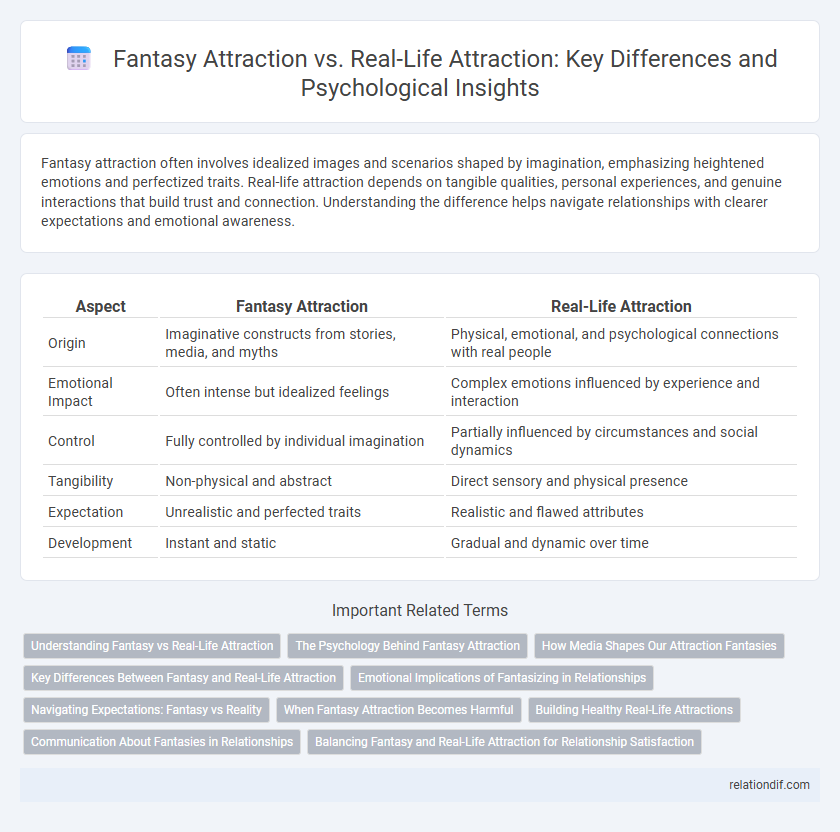Fantasy attraction often involves idealized images and scenarios shaped by imagination, emphasizing heightened emotions and perfectized traits. Real-life attraction depends on tangible qualities, personal experiences, and genuine interactions that build trust and connection. Understanding the difference helps navigate relationships with clearer expectations and emotional awareness.
Table of Comparison
| Aspect | Fantasy Attraction | Real-Life Attraction |
|---|---|---|
| Origin | Imaginative constructs from stories, media, and myths | Physical, emotional, and psychological connections with real people |
| Emotional Impact | Often intense but idealized feelings | Complex emotions influenced by experience and interaction |
| Control | Fully controlled by individual imagination | Partially influenced by circumstances and social dynamics |
| Tangibility | Non-physical and abstract | Direct sensory and physical presence |
| Expectation | Unrealistic and perfected traits | Realistic and flawed attributes |
| Development | Instant and static | Gradual and dynamic over time |
Understanding Fantasy vs Real-Life Attraction
Fantasy attraction often involves idealized scenarios shaped by imagination and media, emphasizing emotional intensity and escapism rather than realistic interaction. Real-life attraction is grounded in tangible experiences, physical presence, and interpersonal chemistry, influenced by sensory cues and social dynamics. Understanding the distinction helps individuals navigate expectations and build healthier relationships based on authentic connections rather than idealized fantasies.
The Psychology Behind Fantasy Attraction
Fantasy attraction stems from the brain's ability to create idealized scenarios that fulfill emotional or psychological needs often unmet in real life. Neural pathways associated with desire and reward, such as dopamine activation, play a significant role in sustaining fantasy attraction by offering a safe mental escape from reality. This type of attraction leverages imagination and personal fantasies, which can influence motivation, self-perception, and even relationship satisfaction in real-life contexts.
How Media Shapes Our Attraction Fantasies
Media profoundly influences attraction fantasies by portraying idealized versions of beauty, romance, and desire, often detached from real-life complexities. Cinematic and digital narratives emphasize exaggerated traits and scenarios, shaping audience expectations and altering perceptions of attractiveness and partner compatibility. This media-driven idealization can create a disparity between fantasy attraction and genuine interpersonal connections, impacting how individuals approach relationships.
Key Differences Between Fantasy and Real-Life Attraction
Fantasy attraction often involves idealized or exaggerated traits tailored to personal desires or imagination, whereas real-life attraction is influenced by tangible characteristics such as personality, physical presence, and social interaction. Emotional depth and mutual understanding typically shape real-life attraction, contrasting with the primarily visual or scenario-based nature of fantasy attraction. Real-life attraction requires ongoing reciprocity and communication, which fantasy attraction lacks due to its one-sided and imaginative foundation.
Emotional Implications of Fantasizing in Relationships
Fantasy attraction often evokes intense emotional responses by allowing individuals to explore desires without real-world consequences, enhancing imagination and emotional fulfillment. However, relying heavily on fantasy attraction can lead to unrealistic expectations in real-life relationships, potentially causing dissatisfaction and emotional disconnect. Balancing fantasy with genuine emotional intimacy is crucial for maintaining healthy and fulfilling romantic connections.
Navigating Expectations: Fantasy vs Reality
Navigating expectations in fantasy attraction versus real-life attraction involves understanding the gap between idealized desires and authentic human connection. Fantasy attraction often centers on exaggerated traits and scripted scenarios, while real-life attraction requires embracing imperfection and emotional complexity. Managing this balance fosters healthier relationships and realistic personal fulfillment.
When Fantasy Attraction Becomes Harmful
Fantasy attraction becomes harmful when it distorts expectations and impairs real-life relationships, leading to dissatisfaction and emotional detachment. Unrealistic ideals shaped by media or imagination can create barriers to authentic connections and communication between partners. Recognizing the difference between fantasy and reality is essential for maintaining healthy intimacy and mutual respect.
Building Healthy Real-Life Attractions
Building healthy real-life attractions involves cultivating genuine emotional connections, mutual respect, and shared experiences rather than relying on fantasy-based ideals. Real-life attraction grows through open communication, trust, and understanding each other's values and boundaries. Prioritizing authenticity over fantasy helps create sustainable, meaningful relationships grounded in reality.
Communication About Fantasies in Relationships
Open and honest communication about fantasies strengthens emotional intimacy and builds trust in relationships, allowing partners to explore desires safely. Distinguishing between fantasy attraction and real-life attraction helps avoid misunderstandings and aligns expectations. Discussing fantasies fosters mutual respect and enhances satisfaction by acknowledging individual needs within the partnership.
Balancing Fantasy and Real-Life Attraction for Relationship Satisfaction
Balancing fantasy attraction and real-life attraction is crucial for relationship satisfaction, as fantasy often fuels excitement while real-life attraction builds trust and emotional connection. Research shows that aligning fantasies with realistic expectations enhances intimacy and prevents disappointment, fostering stronger bonds between partners. Couples who communicate openly about their fantasies and desires experience higher levels of relationship fulfillment and long-term happiness.
Fantasy attraction vs real-life attraction Infographic

 relationdif.com
relationdif.com